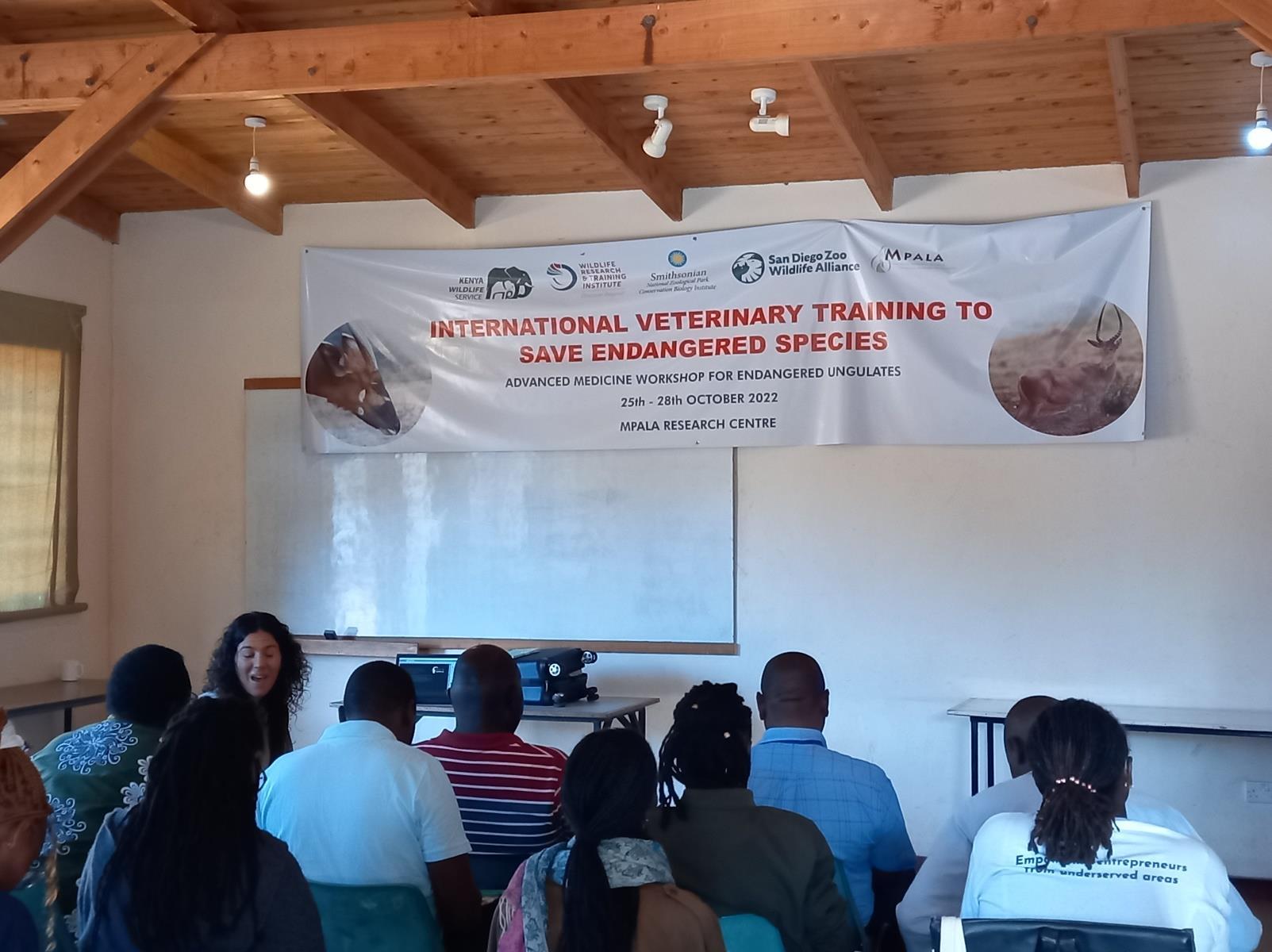SWT/KWS MERU MOBILE VETERINARY UNIT OCTOBER 2022








October was characterized by increased environmental temperatures and strong winds in the early mornings, with each passing day came a substantial decline in the available forage and water for wildlife in the Meru ecosystem. During the month under review, the Meru Mobile Veterinary Unit attended to 9 cases i.e. 4 rhino cases, 1 elephant case, 3 giraffe cases and 1 security dog case. These cases involved the rescue of an orphaned white rhino calf in the Meru Rhino Sanctuary; the translocation of 4 white rhinos from Meru National Park to Partakilat Wildlife Sanctuary, Maasai Mara; the rescue of a heavily pregnant giraffe and her offspring trapped in a fenced enclosure for almost 6 days without access to water and other interventions highlighted below
The Meru Mobile Veterinary Unit is grateful for the generous funding received from Sylvie Chantecaille through Sheldrick Wildlife Trust. The Unit also appreciates the support it receives from other conservation partners, local communities and Kenya Wildlife Service through the Senior Assistant Director - Eastern Conservation Area and the Head - KWS Veterinary Department.
Date
Species Area Found
Outcome
01-Oct 22 Rhino Meru Rhino Sanctuary Postmortem Adult white rhino carcass found in the park Natural causes
02-Oct 22 Rhino Meru Rhino Sanctuary Rescue 7-month-old male white rhino calf orphaned after its mother died Task successful
12-Oct 22 Rhino Meru Rhino Sanctuary Natural Causes Filariasis-like lesion to the left rump Successfully treated
13-Oct 22 Rhino Meru Rhino Sanctuary Relocation
Translocation of 4 white rhinos to start a new population in a Conservancy in Mara Task successful
13-Oct 22 Elephant Meru N.P. Postmortem Adult male elephant carcass found in the Kiboko area, Meru National Park Died

16-Oct 22 Giraffe Garissa Snared Wire snare around the neck Task successful
16-Oct 22 Giraffe Garissa HWC Fresh wound on the right hind leg Successfully treated
16-Oct 22 Giraffe Garissa HWC 2 giraffes trapped in a fenced enclosure for almost 6 days without access to water Successfully treated
31-Oct 22 Security Dog Meru N.P. Technical Case Prophylactic treatment for trypanosomiasis Task successful


The Rhino Monitoring team reported finding an adult rhino carcass identified as Suzie, a 23-year-old female white rhino, who had left behind a 7-month-old calf. A search was immediately mounted to find the calf.

Suzie was found lying on her right side with both horns intact. The neck muscles, masseter muscles, mammary glands, and perianal region had been scavenged. Internal and external examination of the skin on both the left and right side of the body was done; there was no skin breakage due to a foreign object. From the examination of the abdominal viscera, there was scavenging of the rectum, large intestines, small intestines, 2/3 of the liver, spleen, and the right kidney. The rest of the abdominal organs were in an advanced stage of autolysis. The vet also examined the thoracic cavity, portions of the lungs, pericardial sac, and diaphragm muscles all of which had been scavenged. Incision of the heart from the base of the apex through the interventricular septum revealed petechial haemorrhages on the ventricular muscles.
The scavenging of most of the internal organs, and the carcass being in an advanced autolysis stage were limiting factors for a meaningful autopsy examination. Therefore, based on gross examination, Suzie is suspected to have died from natural causes.

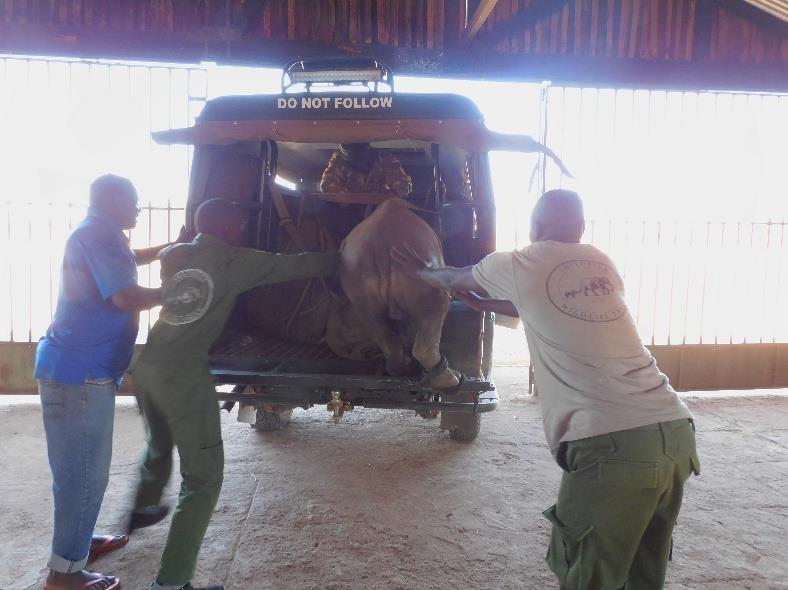
Efforts were made on the evening of 01st October to locate and capture Suzie’s 7-month-old male calf with no success. The search continued the following day when the calf was found by the Meru Rhino Monitoring team in the morning hours. Aerial support to monitor the calf’s movements was provided by the KWS fixedwing aircraft based in Meru N. Park
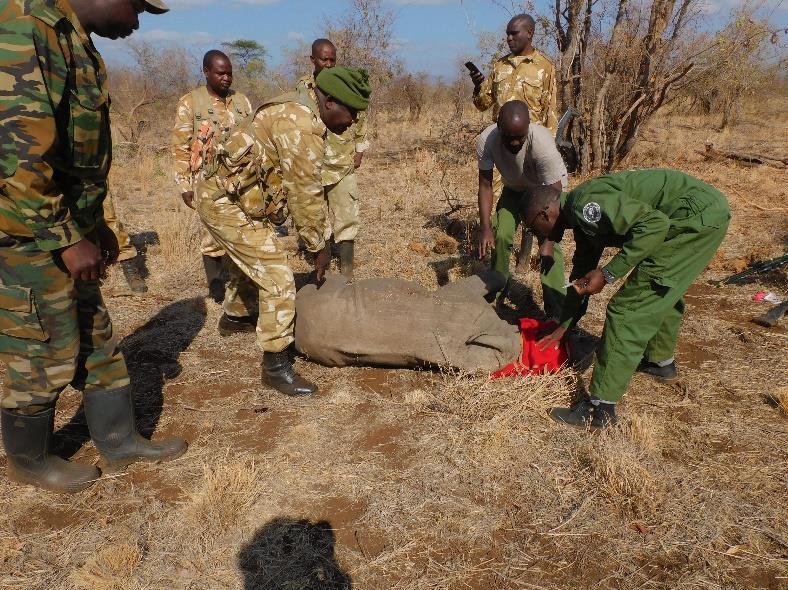
The calf was approached on foot and darted on the right rump with 1 mg Etorphine and 10 mgs Azaperone. He was startled and ran for about 50 metres before the drugs took effect. He was then secured, blindfolded, physically restrained, and doused with water to aid in cooling his body. He was then taken to a holding room 15 mgs Butorphanol were administered intravenously to manage respiratory depression before reversing the anaesthesia with 20 mgs Naltrexone (10 mgs intravenously & 10 mgs intramuscularly). The rhino calf was later given 40 mg Azaperone intramuscularly and loaded into a well-ventilated lorry with a sand cushion on the floor and transported to the KWS Headquarters in Nairobi for nurturing.

While on a routine monitoring patrol in the Meru rhino sanctuary, the Meru Mobile Veterinary Unit identified an adult white rhino bull with a filariasis-like lesion to the left rump. The rhino was treated in collaboration with the Mount Kenya Mobile Veterinary Unit.


The Rhino was darted from a helicopter with 3.5 mgs Etorphine and 60 mgs Azaperone. The dart landed on the right rump, and the drugs took effect 4 minutes later The bull was quickly secured and blindfold then 20 mg Butorphanol were administered intravenously to improve respiration. The filarial wound on the rump was approx. 12 inches in diameter. Blood and tick samples were collected before commencing treatment. The wound was thoroughly cleaned with water, flushed with Hydrogen peroxide and covered with Iodine. An antibiotic spray cover was applied to manage cutaneous infections and keep flies off. 60 mls Ivermectin and 15,000 mgs Amoxicillin were administered before reversing the anaesthesia with 25 mgs Naltrexone administered intravenously and 12 mgs Diprenorphine administered intramuscularly. The rhino rose 2 minutes later.
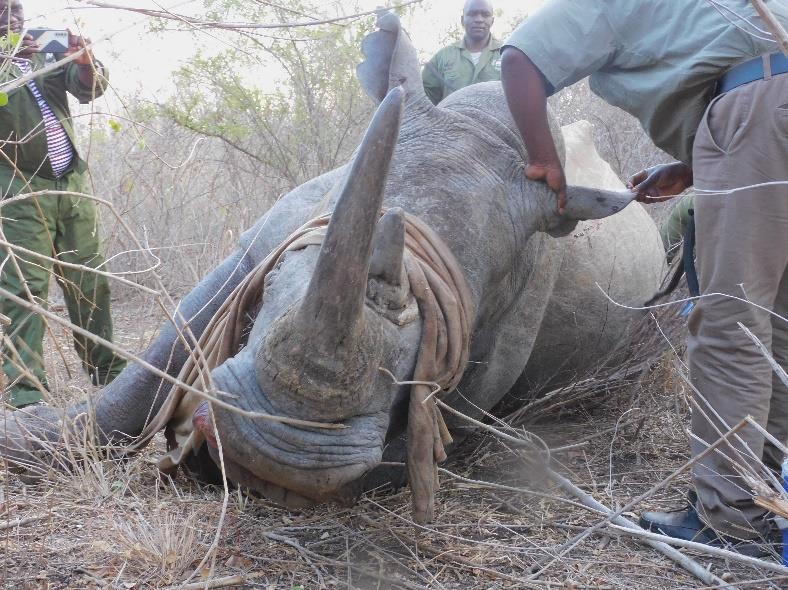
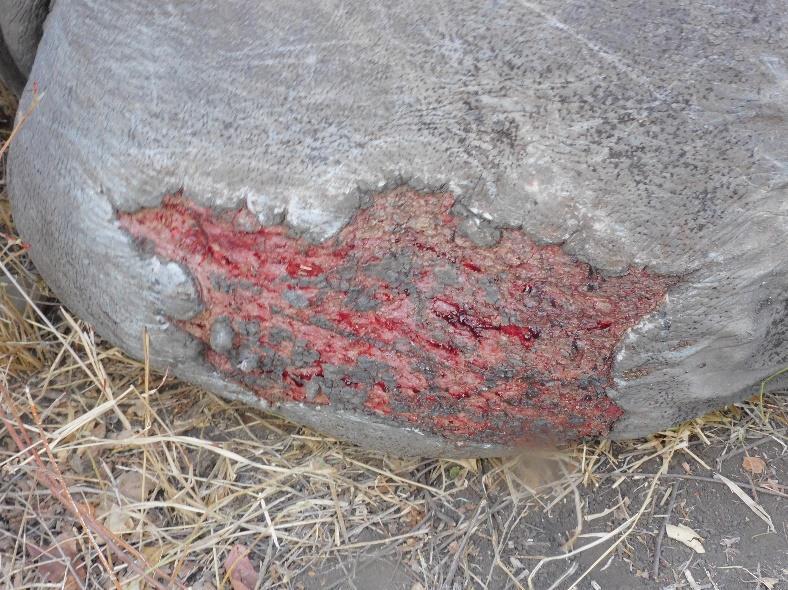
The rhino has a good prognosis
The Meru Mobile Veterinary Unit and wildlife capture personnel drawn from the KWS Veterinary Department participated in the translocation of 4 white rhinos (1 male and 3 females) from Meru National Park to Partakilat Wildlife Sanctuary, Maasai Mara.




The rhinos were darted from a helicopter with a combination of Etorphine and Azaperone, the dosage was calculated using the animals’ body weight. Once darted, the rhinos were manoeuvred to an open area easily accessible by vehicles. They were secured, blindfolded and doused with water to help cool them before they were loaded into crates. Based on the milligrams of Etorphine used, Butorphanol was administered to counter respiratory depression and improve the oxygenation of body tissues. Vital parameters were regularly monitored during the exercise, and free oxygen was provided from a cylinder. Various body measurements were taken, and samples (faecal, whole blood, serum, ticks, and tissue) were collected for analysis and datakeeping. Anaesthesia was reversed with Naltrexone intravenously and Diprenorphine intramuscularly. Immediately after the rhinos were up, they were nudged into the crates and secured for transport
The Meru Veterinary Unit carried out a post-mortem examination on an adult male elephant carcass found in the Kiboko area, Meru National Park. Both tusks had been recovered by the KWS patrol teams.
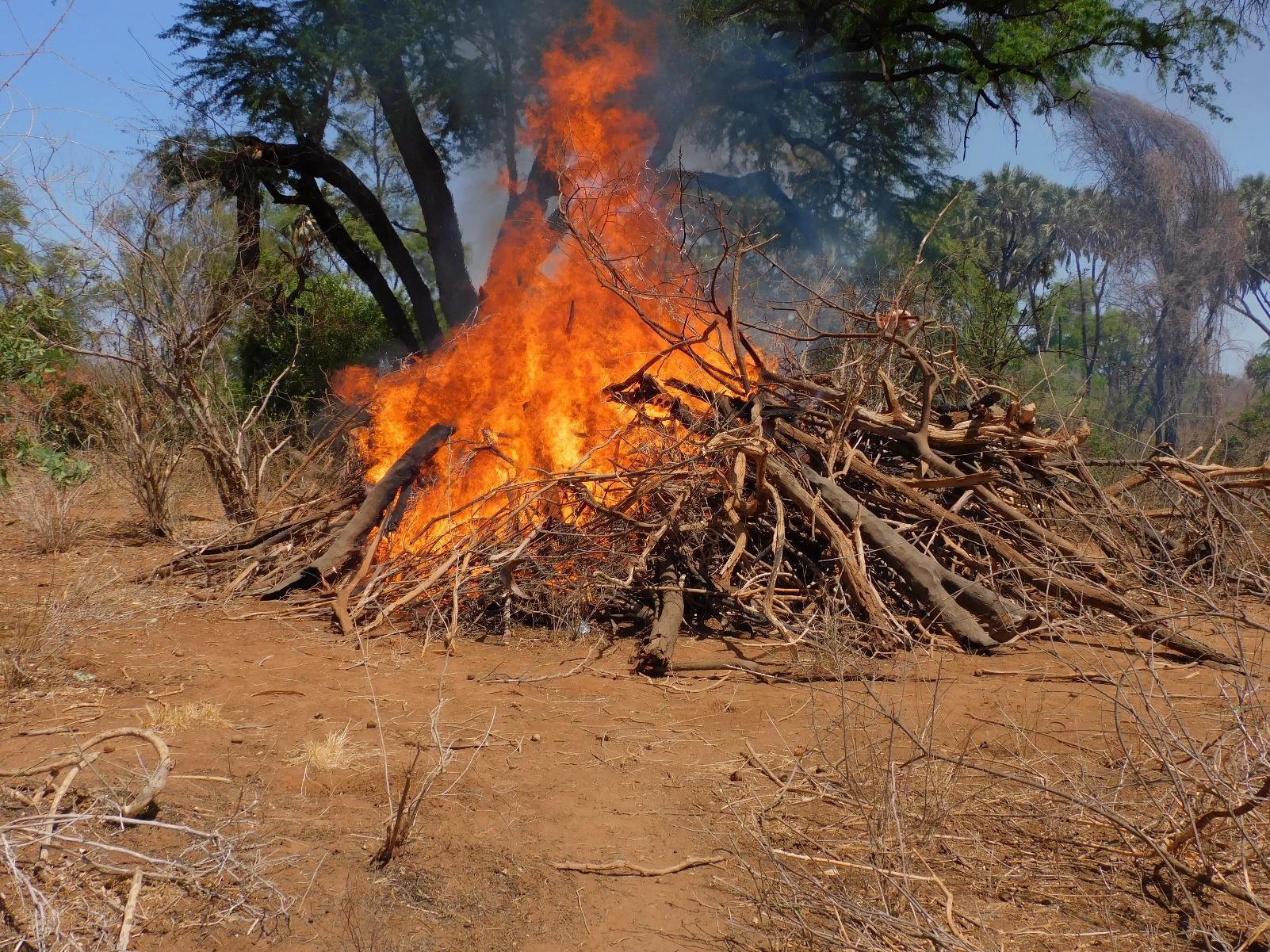
The carcass was found lying on its right side in pools of dark, thickened and un-clotted blood. Blood oozed from the trunk, anal and urethral orifices with marked bloating and rapid body decomposition. Examination of the forelimbs revealed that the carcass had undergone incomplete rigor mortis. The post-mortem findings were suggestive of anthrax. In case anthrax was confirmed, the vet recommended that the carcass be destroyed by deep burying or burning to avoid mortalities in wild carnivores due to scavenging of the carcass and large numbers of vegetative bacilli cells being exposed to the air. Peripheral blood smears collected at the ear tip for laboratory examination were negative for anthrax.
Implementation of enhanced and timely wildlife disease surveillance to identify prevalent diseases for prevention and control; Mitigating wildlife-livestock interactions, especially during the dry seasons, to avoid disease transmission at the interface; Prompt reporting of carcass sightings within the Meru ecosystem to enhance identification and prevention of disease outbreaks.
The KWS Deputy Warden Garissa Station reported a snared adult giraffe bull and an injured juvenile male giraffe.




The adult male giraffe was darted on the right rump with 15 mgs Etorphine and 40 mgs Azaperone. Induction took 10 minutes then the giraffe was roped to the ground and blindfolded. The wire snare around the neck was removed, luckily it had not cut into the flesh. An antibiotic spray was applied over the alopecic areas the snare was rubbing on before reversing anaesthesia with 200 mg Naltrexone injected into the jugular vein. The giraffe rose after 3 minutes and ran away.
Due to timely veterinary intervention, the prognosis for recovery is good since the wire snare had not inflicted severe injuries.
After de-snaring the giraffe bull highlighted under Case 6, the Meru Mobile Veterinary Unit attended to a juvenile male giraffe with a fresh wound on the right hind leg.

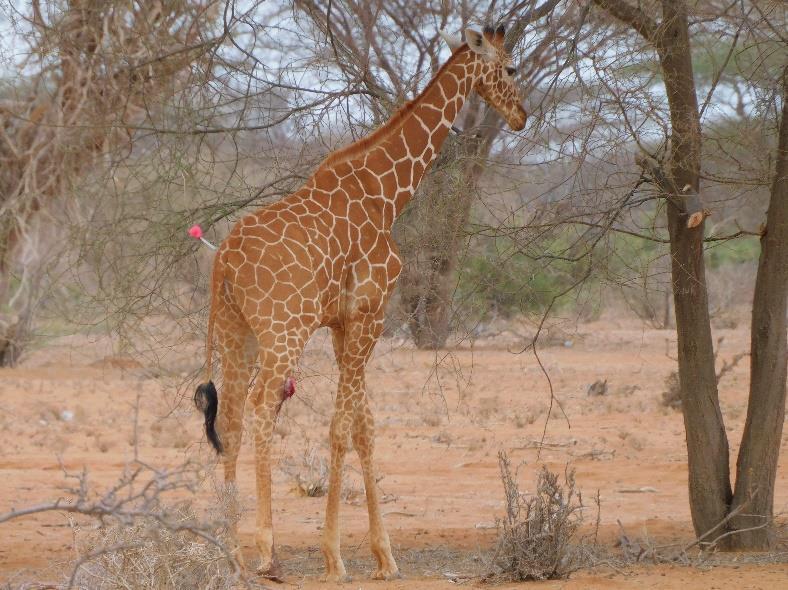


The giraffe was darted on the left rump with 8 mgs Etorphine and 20 mgs Azaperone. Complete immobilization was achieved after 5 minutes. The giraffe went down on left lateral recumbency, it was manually restrained and blindfolded then anaesthesia was immediately reversed with 100 mgs Naltrexone administered through the jugular vein. A fresh clean-cut wound was observed on the right hind leg proximal to the ankle joint, it was suspected that the wound was inflicted by a sharp object. An examination of the fibula bone showed it was intact. The wound was cleaned with water, flushed with Hydrogen peroxide and Iodine, and packed with green clay. An antibiotic spray was also applied on the treated wound to keep off flies and manage bacterial infections. 60 mg Dexamethasone sodium and 6,000 mg Amoxicillin were administered then the giraffe was released.
Since the bone structure was intact, the prognosis for recovery is good.
After attending to the 2 giraffes highlighted under Case 6 and Case 7, the Meru Mobile Veterinary Unit was informed of 2 other giraffes that had been trapped in an enclosure for almost 6 days without access to water.
A heavily pregnant adult giraffe and a sub-adult female giraffe, suspected to be the adult’s offspring, were found in the enclosure. The pair had broken through the fence and were unable to get out. Attempts were made to slowly drive them out through the enclosure’s gates with no success. Based on the fatal risks arising from the high environmental temperatures, dehydration and physiological state of the animals, a decision was made to cut a section of the fence to enable them to leave freely. The giraffes left the enclosure later that night and were free to access food and water.


A security dog in Meru National Park received prophylactic treatment for trypanosomiasis. Canine trypanosomiasis is transmitted by biting flies like tsetse flies, and it can be fatal particularly in camels and dogs. The disease can result in high mortalities without proper prevention, especially in endemic areas. It is characterized by anaemia, fever, generalized weakness and staggering gait.
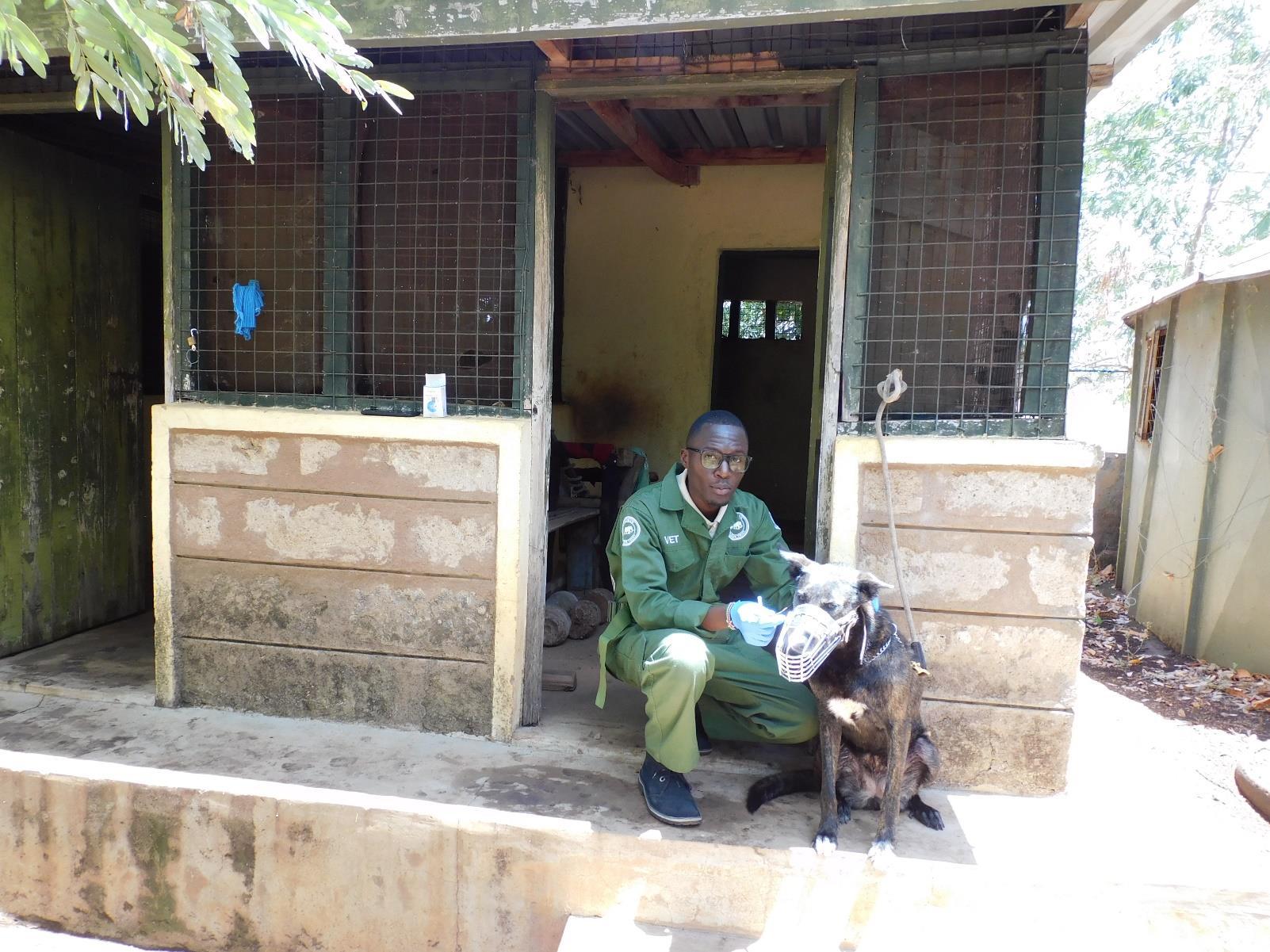
The security dog was allowed to familiarize herself with the vet to avoid excitation and to facilitate examination. She was alert, well hydrated and she had a shiny, smooth coat. The drug dosages were calculated based on the recorded body weight. She was muzzled then 0.8 mls Triquin® (Quinapyramine sulphate & Quinapyramine chloride) was injected subcutaneously on the right side of the neck.
The prognosis is good as no adverse reactions were noted after treatment.
The 4-day workshop aimed to provide advanced training in veterinary care, disease surveillance, pathology and research protocols so that veterinarians who work with eastern mountain bongo and hirola in Kenya are equipped with the skills required to identify and address health threats to these species.


There was a series of lectures as well as laboratory and field-based practical sessions delivered by international and Kenya-based experts.
